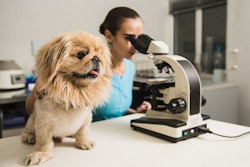
Updated from 2017
Elk and bison ranches provide healthy novel proteins for dog and cat food while allowing pet food brands to make sustainability claims because the animals cause less ecological damage than cattle. By using organ meat and by-products from bison and elk, the pet food industry helps to increase the market for the whole animal, further increasing efficiency and sustainability. What’s more, elk (Cervus canadensis) and bison (Bison bison) are still relatively rare in pet foods, so including them as a novel protein can help a brand stand out.
“As more people discover the great taste and nutritional attributes of sustainably raised bison, they want their companion animals to enjoy the experience as well,” said Dave Carter of the National Bison Association in 2017.
Elk and bison in pet food
An increasing interest in sustainable agriculture, wilderness conservation and alternative meats may be boosting demand for bison and elk meat and other products. However, while elk and bison populations are increasing in North America, they remain uncommon in pet foods. In Petfood Industry’s Pet Food Product Database, 36 pet foods, treats and supplements included American bison (Bison bison) in their descriptions. Only seven products mentioned elk, most of them antler chews for dogs.
Two decades ago, bison ranchers mostly marketed tenderloins, ribeyes and strip steaks, resulting in freezers full of unsold chuck, roasts, trim and co-products, said Carter, but now demand for every part of the animal is growing.
“The demand for bison in pet food is creating strong demand for hearts and livers as well,” said Carter.
Likewise with elk, butchers use everything but the bugle (elks’ call), to paraphrase pig farmers who use everything but the squeal.
“Elk’s large carcasses yield hundreds of pounds of meat that is highly desired in North America,” said Brenda Hartkopf of the Elk Breeders Association in 2017. “Hard antler traditionally was used for antler décor but now the dog chew market has taken the elk industry by storm. In addition to its delicious taste, the meat is high in protein and low is both fat and cholesterol.”
Ecological advantages of elk and bison farms
Some scientists and sustainability advocates have pointed out the pollution and resource use resulting from domesticated livestock, particularly cattle. For example, research published in the Proceedings of the National Academy of Sciences concluded that reducing beef consumption, more than any other meat, would mitigate the environmental damage resulting from human diets.
However, North American elk and bison ranchers may have a much smaller negative effect, since the animals evolved in harmony with the American ecosystem. Elk and bison were once widespread throughout what is now the United States, Canada and even northern Mexico in the case of the bison. Hunting and habitat loss dramatically reduced the range and populations of both species.
Elk and bison farms help wildlife conservation
“In the 1880’s, bison teetered on the brink of extinction, with an estimated 750 remaining in North America," said Carter. “Today, the North American population is estimated at 400,000 head, with more than 90 percent on farms and ranches.”In the past few decades, efforts by conservationists and others have restored both species to fragments of their former range. Along with reintroduction to the wild, ranchers now raise bison and elk to supply the human and pet food industry with meat.
“To be clear, domestic elk ranching is separate from free-ranging elk,” said Hartkopf. “It is illegal for an elk rancher to possess a wild elk or release a farmed elk into the wild. However, elk ranching has helped the elk world in general as it has provided the continent with a steady supply of elk meat and elk products. This allows there to be less reliance on wild elk herds, which preserves their numbers.”
Elk reintroduction into Great Smoky Mountains National Park began in 2001. These elk live in the Cataloochee Valley, North Carolina, USA. March 26, 2017 | photo by Tim Wall
Also, elk ranchers and their veterinary staff have learned about elk health, which in turn informs management of wild elk, she said. For example, elk and deer ranching associations have spent millions of dollars researching maladies such as chronic wasting disease.
Sustainability of elk and bison ranching
While elk and bison may live on ranches, they require less help from the ranchers than cattle. Along with needing less assistance from humans, both bison and elk can thrive on land where cattle would suffer.
“An advantage for elk ranchers is elk can be raised on marginal land that may not otherwise be useful for farming or cattle ranching,” said Hartkopf.“The grassland ecosystems of North America (comprising more than 30 percent of the landmass) evolved in concert with bison and other grazing animals,” said Carter. “Those grasslands are vital in helping to remove carbon from the atmosphere and sequestering it in the soil. [Bison] ranchers are managing their herds to maintain healthy grasslands, and to build healthy soil.”
As undomesticated livestock, bison retain many of their natural behaviors, he said. For example, they tend to cause less damage to waterways than cattle. Historically, predators prowled around streams, ponds and other water sources, so bison tend to drink then move away. On the other hand, cattle are more likely to linger on the banks, resulting in erosion and other damages to riparian ecosystems.
Although kept on ranches, bison retain many of their instinctual behaviors. | photo by DMPhoto | BigStockPhoto
The sustainable use of elk, bison and other undomesticated animals in pet food may help people to connect to wildlife in general, by encouraging awareness of conservation issues. Primatologist Jane Goodall has commented that her first experience with the personalities of animals was with her pet dog. As people increasingly recognize the personhood of dogs and cats by humanizing their pets, wildlife may also receive higher regard.
“From my experience, people who love animals, love all animals and have great respect for wildlife and conservation efforts to help preserve both species and their habitats,” said Sandy Robins, pet lifestyle author and consultant. “It’s also about being a voice for the voiceless. And it doesn’t matter if it’s a domestic cat that meows or a big cat that roars.”




